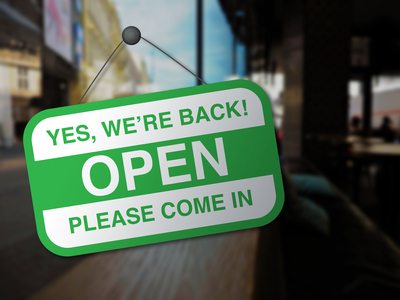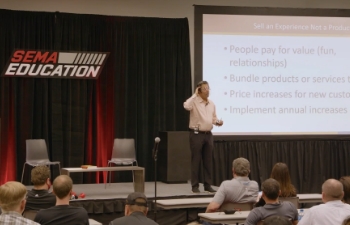RETAIL BEST PRACTICES
Getting Back to Business
How to Recreate Your Brand Around New Realities
 Unlike other business-disruption events, the coronavirus has changed everything about the retail experience. There may be no going back to the way things were before, but there are ways to make your business better than ever. Photo courtesy: Shutterstock.com |
As of May 20, 2020, all states with stay-at-home orders began lifting their restrictions, including those pertaining to commerce. But while America’s retail sector has been getting back to business, it hasn’t been business as usual—and things likely will be different for some time to come.
The constraints on business reopenings continue to vary by state and county. Overall, they are driven by the three-phase reopening plan set forth several months ago by the White House, based on recommendations from the Centers for Disease Control and Prevention (CDC) and other leading COVID-19 health experts.
Each phase of the plan assumes a different set of responsibilities for business operations based upon numerous factors, including the risk of coronavirus spread in a given locality. For example, the first phase calls for employers to monitor employee temperatures as they return to work while placing strict limits on occupancies of workplaces and public venues. Personal protective equipment (PPE) for employees and customers also features prominently. While many constraints gradually relax as reopening approaches the third phase, social-distancing requirements in one form or another remain in force throughout.
Amid the relaxing of regulations, aftermarket retailers may be eager to reestablish their brands and get back to the way things were before. But according to branding strategist Mike Brown of Brainzooming, that would be a big mistake. That’s because there’s a new normal in play, and it revolves around changed customer expectations.
As the presenter of a six-part SEMA Education webinar series entitled “Jumpstart Business Operations,” Brown emphasized the uniqueness of the current business climate.
“Different from 9/11 and different from, really, almost anything else probably in our lifetimes where a certain group of people experienced something directly and everyone else may have seen it, may have felt like they experienced it, or may have seen ripples of it in their life and how they do business, everybody has had a direct impact with this COVID-19 pandemic,” he explained.
That impact has significantly altered customer shopping and purchasing habits, including everything from when and how (or even whether) they choose to physically interact in a retail space, to the lens through which they now view marketing messages. From Brown’s perspective, the key to successfully reestablishing your brand will be understanding those expectations and making specific physical and brand adjustments to meet and exceed those expectations. In short, success requires thinking in terms of business improvement, not business recovery.
First Things First
The first area to address is the safety of your physical retail space, along with the health of your employees. In fact, making them your priority will also lay a strong foundation for the overall well-being of the customers who step into your business.
In addition to regularly cleaning and sanitizing your entire operation per CDC and government guidelines as well as issuing the appropriate PPE and enacting social-distancing measures, there are a host of other best practices to consider for mitigating COVID-19. They include erecting other physical barriers or safeguards; human resources and employee training; hours, benefits and other return-to-work issues; and even supply-chain and inventory-control measures.
The list is too extensive to cover here, but the Retail Industry Leaders Association (RILA) has produced several excellent, comprehensive guides—complete with planning checklists covering all the above points—that can be found at www.rila.org/coronavirus-resources-for-retailers. Federal reopening guidelines can also be found at the CDC’s Coronavirus Disease 2019 webpage at www.cdc.gov/coronavirus/2019-ncov/community/reopen-guidance.html. The page includes links to U.S. Environmental Protection Agency (EPA) cleaning and disinfection guidelines as well as a cleaning and disinfection decision tool for determining what in your environment may be affected.
Next Step: Evaluation
Brown advised taking three steps to reinvigorate your retail brand in addition to the physical logistics of reopening. The first is to seriously evaluate the changed landscape. Look at your brand promise as it existed and assess the new constraints being forced on that brand experience.
“Maybe you’re coming back online and you’re expecting less demand and you’re only going to have half of your team, so you’re not going to be able to serve as many people,” he said. “Or maybe you could have had 100 people in your store before but now you can only have 50 in your store at a time. Those are constraints that are being brought into the business.
“Maybe you’re [also] having to take a greater role in wellness and safety. Are you going to have to do temperature checks for employees before they report? What’s that going to be like? Are they agreeable to that, or does it seem weird? Depending upon the size of the store and how you staff, that may add 10–15 min. before they’re on the clock. So are you paying them for that time?”
Customers are also going to be in a different frame of mind, Brown said. Accordingly, you’ll want to assess not only their current product needs but also their needs for a convenient shopping experience. What makes shopping uncomfortable, difficult or inconvenient for them now? How have their buying habits changed? Do they now rely more on online purchasing, curbside pickup, delivery, or touchless payment options? Are they inconvenienced by the new traffic patterns inside your store? By having to wait in a line outside? Those are just some of the things to look at.
Map a New Experience
Now comes the innovation—engaging in an exercise Brown calls “experience mapping.” Essentially this is how you will recreate your brand around the new realities and come up with novel ways to deliver on your retail promise.
“It’s where you’re actually looking at that process of interaction between your employees and customers and seeing what it was like before the pandemic hit and the ways that they interacted,” Brown noted. “Which of those things are still valuable and apply? Which ones can’t we do anymore? And how do we fill in the middle? It’s coming into your retail environment and seeing the things your customers are noticing and asking what that experience is like and if it is all supporting what you want their experience to be with your brand. How are you working with that? How can you innovate around everything else? And that becomes the new brand experience.”
Because your employees are on the front line of customer interactions, they can contribute greatly to developing any new strategies.
“Even if you’ve got only three people, get together,” Brown urged. “There’s no reason managers need to think up all this stuff on their own. Their employees have been having experiences. Their employees have been to other retail environments. Their employees have been to other places. Talk about what they are seeing working in those other environments.”
Brown also encourages owners and managers to take advantage of other retail opportunities and experiences and go to school on them.
“What can we learn?” he asked. “What would we want to avoid? How can we take something from a completely different business and make that work for us to make our experience better. You can always go to school on somebody else.”
Most of all, don’t hesitate to think outside the box. Brown pointed to a ritzy Seattle restaurant that changed its entire business model in a matter of 10 days.
“They blew up their dining room from a fine-dining concept to a three-star restaurant because they realized fine dining is out right now,” he explained. “But they can do a hamburger place, they can do a bagel place in the morning, and they can do pickup dinners.”
 First things first: Complying with the reopening guidelines set by federal, state and local authorities is paramount. Fortunately, there are resources to help you develop a checklist applicable to your specific business. Photo courtesy: Shutterstock.com |
Realign Your Messaging
The final component in getting back to business is absolutely crucial: realigning your marketing, advertising and social-media messaging.
“You need to move your messaging to talk very personally to people,” Brown said. “You can’t just have a blanket message. Obviously, you’re not going to customize an ad or email for every person, but you have to at least convey that you understand that everybody has been impacted and that, while you may not know exactly how they’ve been impacted, you’re cognizant of that and are approaching them in a way that is sensitive and respectful and open to how their needs and their expectations may differ based on how they’ve been touched.”
Brown noted that branded messaging around health and safety has continually resonated with consumers throughout the COVID-19 crisis, as opposed to messaging conveying a business-as-usual tone.
“It’s one of those cues that you feel either directly or indirectly—that if I’m getting an email from somebody and it’s clear that they’re not really thinking about what the retail experience is, well, maybe they’re not accounting for employees in masks. Maybe they’re not accounting for social distancing, because their communication isn’t reflecting that they’re thinking about any of those things,” he explained, adding that it’s far better to focus on customer expectations as the economy reopens.
“It’s another great opportunity for retailers to give customers education and information up front about what the new experience will be like when they come to your store,” he suggested. “What’s going to happen? Because it will not only potentially get them over that hurdle of [whether it’s] just going to be a pain in the rear or what the service experience is going to be like. It helps them understand what you’re doing about that. And it also helps them be a lot more efficient when they’re in the store, because it’s different.”
For instance, you may have one-way aisles now and different traffic patterns. Or perhaps you used to do demos but you’re not going to have them anymore.
“People are going to be confused,” Brown said. “It’s a lot for them to learn when they’re in your retail environment, and it’s going to slow things down. If you can have only a limited number of people coming through, you want them to take the full time needed to buy the cart level that you want them to, but you don’t want them to take an extra 30 min. to buy the same amount of goods and basically push out other opportunities for you. As a retailer, you’ve got a vested interest in pre-educating customers and making sure they’re familiar and comfortable with the experience so that they can be more efficient when they’re in the retail environment.”
Better Than Before
No one can predict exactly how a post-pandemic climate will look in months or even a year from now, and the current retail environment seems to be changing minute to minute. For many small businesses, this is a period of challenge, but it’s also an opportunity to adopt the latest best practices (and maybe some that you should’ve been implementing all along).
“Everybody’s got to change,” Brown said. “Right now, almost every retailer is having their experience changed as they open back up. It has been forced on them. The retailers who can think about the experience they delivered before and how they can innovate and change to still deliver that same type of experience while recognizing safety and health, and recognizing the constraints, are going to win over those retailers who can’t deliver that.”
| Executive Summary | |
As the retail economy reopens in the wake of COVID-19, don’t expect to get back to business as usual. Rather, navigate the new normal and seize the opportunity to be better than before. The following are four steps that can guide you in rebranding. Lay the Foundation. Enact all the health and safety measures required by federal, state and local regulations in regard to your particular phase of reopening. Those include regular cleaning procedures, issuing PPE and appropriate social distancing. Taking care of your employees also helps to take care of your customers. Evaluate the Changed Retail Landscape. List all of the constraints your business must now deal with. They will include the changes you’ve made in step one above and all the ways your customers’ normal retail experience is now impacted. Map Your New Course. Examine how your retail brand previously engaged customers and brainstorm new ways to overcome the constraints and deliver that brand experience. Look to other retail spaces for examples, and include employees in the process. Think outside the box. Adjust Your Messaging. This is a crucial component of your renewed brand experience. Make your message personal and understanding of customer concerns. Pre-educate them about the changes to your business model. |
| Resources | |
SEMA COVID-19 Webpage (www.sema.org/coronavirus): The association continues to update its COVID-19 webpage to provide members with valuable resources for addressing the coronavirus. The information is comprehensive and ranges from industry best practices for protecting employee health to tracking the states as they go through each phase of reopening. Members are encouraged to bookmark the page and visit often. Alliant Insurance Services: A SEMA Member Benefits partner, Alliant has prepared a “Return to Work Guide” containing practical information and tools to help facilitate an employer’s return-to-work process. The company also offers a national business insurance program to support SEMA members. For information, contact Alliant Senior Vice President Bob Corwin at bcorwin@alliant.com or 619-204-9008. |








